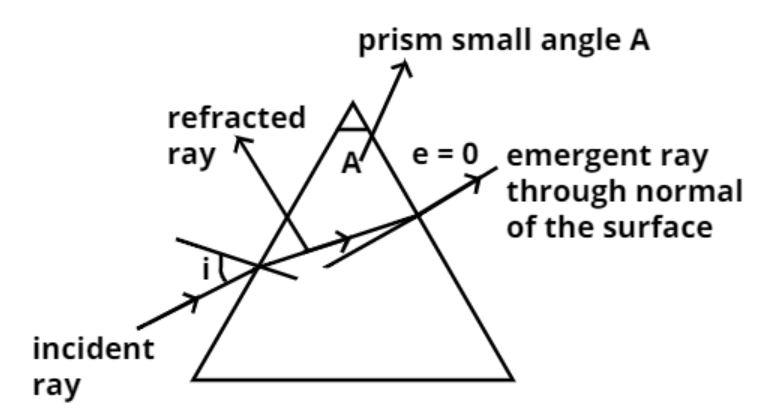
A ray is incident at an angle of incidence i on one surface of a prism of small angle A and emerges normally from the opposite direction. If the refractive surface of the material of the prism is
Answer
427.8k+ views
1 likes
Hint: In this question use the concept that since incident ray emerges normally from the opposite surface of the prism so the angle of emergence becomes zero that is
Complete step-by-step solution:

Given data:
Angle of incident = i
Prism small angle = A
Refractive material of the prism =
Let the angle of emergence = e
Now it is given that the incident ray emerges normally from the opposite surface of the prism so the angle of emergence becomes zero.
Let angle of deviation in the prime be
So as we know the relation between angle of deviation (
Now as we know in a prism, a small angle of prism plus angle of deviation in a prism is equal to the sum of angle of incidence and angle of emergence.
Therefore, we have,
Now substitute the value from equation (1) and (2) in equation (3) we have,
Now simplify the above equation we have,
Now cancel out the positive, negative same terms we have,
So this is the required angle of incidence such that the prism has small angle A and emerges normally from the opposite surface.
So this is the required answer.
Hence option (C) is the correct answer.
Note – It is important to understand the concept of angle of prism as any angle inside a prism can’t be considered as the angle of the prism. So angle of prism is specifically defined as the angle between those two surfaces of the prism one from which the light enters the prism and the one from which the light goes out of the prism after the refraction.
Complete step-by-step solution:

Given data:
Angle of incident = i
Prism small angle = A
Refractive material of the prism =
Let the angle of emergence = e
Now it is given that the incident ray emerges normally from the opposite surface of the prism so the angle of emergence becomes zero.
Let angle of deviation in the prime be
So as we know the relation between angle of deviation (
Now as we know in a prism, a small angle of prism plus angle of deviation in a prism is equal to the sum of angle of incidence and angle of emergence.
Therefore, we have,
Now substitute the value from equation (1) and (2) in equation (3) we have,
Now simplify the above equation we have,
Now cancel out the positive, negative same terms we have,
So this is the required angle of incidence such that the prism has small angle A and emerges normally from the opposite surface.
So this is the required answer.
Hence option (C) is the correct answer.
Note – It is important to understand the concept of angle of prism as any angle inside a prism can’t be considered as the angle of the prism. So angle of prism is specifically defined as the angle between those two surfaces of the prism one from which the light enters the prism and the one from which the light goes out of the prism after the refraction.
Latest Vedantu courses for you
Grade 10 | MAHARASHTRABOARD | SCHOOL | English
Vedantu 10 Maharashtra Pro Lite (2025-26)
School Full course for MAHARASHTRABOARD students
₹31,500 per year
Recently Updated Pages
Express the following as a fraction and simplify a class 7 maths CBSE

The length and width of a rectangle are in ratio of class 7 maths CBSE

The ratio of the income to the expenditure of a family class 7 maths CBSE

How do you write 025 million in scientific notatio class 7 maths CBSE

How do you convert 295 meters per second to kilometers class 7 maths CBSE

Write the following in Roman numerals 25819 class 7 maths CBSE

Trending doubts
Give 10 examples of unisexual and bisexual flowers

Draw a labelled sketch of the human eye class 12 physics CBSE

Differentiate between homogeneous and heterogeneous class 12 chemistry CBSE

Differentiate between insitu conservation and exsitu class 12 biology CBSE

What are the major means of transport Explain each class 12 social science CBSE

Draw a diagram of a flower and name the parts class 12 biology ICSE




